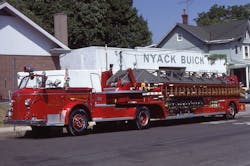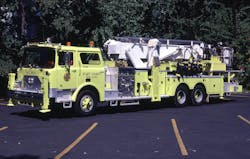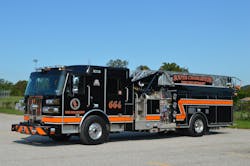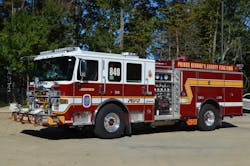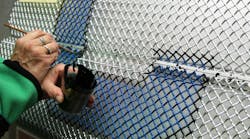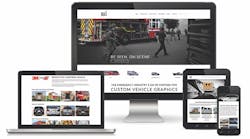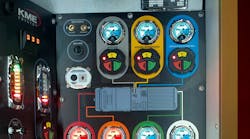Over the past few years, there’s been a trend in the apparatus industry to change the appearance of new rigs, with varying degrees of black color treatments, including on wheels, stepping surfaces, body attachments and aerial devices. Recent trips to regional and national trade shows as well as inspection trips to apparatus manufacturing facilities revealed that the trend is increasing.
The root cause for this “blackout” seems to be the desire of apparatus committees to change the appearance of the apparatus, at times without regard to safety, operations performance or increased cost.
Costly coloration
During the past few months, the cost of new apparatus accelerated dramatically because of a number of factors. These sometimes-double-digit increases have affected many departments’ fleet replacement plans. Furthermore, deliver time frames of all models of rigs have been lengthened, to as long as 18–24 months. Some manufacturers added price escalators into their contracts because of the volatility of metals and materials costs. In addition, where bid specifications would request that the quoted price be valid for at least 60 days—to allow time to review proposals to determine which manufacturer most closely meets the technical specifications—departments are finding that a price is valid only for 30 days or fewer.Apparatus committees generally are responsible for developing requirements that complement the department’s operations while following local jurisdictional purchasing requirements. The most important step in this process is to define the mission of the vehicle, to ensure that the completed apparatus will function as planned and will be capable of safely accessing all areas that are within the response district. Apparatus that are poorly conceived, particularly combination units, such as rescue engines and quints, tend to end up larger and heavier than originally planned and do a lot of things but nothing particularly well.
With the increased use of nationally recognized purchasing consortiums, fewer departments actually write a detailed specification or determine their preferred manufacturer at some point in the process. This methodology allows the apparatus committee to choose from an almost unlimited number of options to configure the vehicle, including specific areas of cab, body and aerial device paint, aftermarket coatings and graphics. There is nothing wrong with some degree of vehicle customization, including company patches, slogans and identification numbers to promote company pride in the apparatus. However, when a vehicle no longer can be identified easily as a fire apparatus, somewhere along the line the mission failed.
The following includes two accounts in which the appearance of an apparatus took precedence over the performance and functionality of the rig.
While conducting a final inspection on a new rear-mount ladder, a department was reviewing its new pumper, which featured blacked out wheels, front bumper, scene and warning lights and pump panels, including black reflective lettering and stripping. What was most striking was that this department also chose to black out all step surfaces, the rear hosebed and dividers with an aggressive black coating. Not much of this design made sense to us, and when we inquired about the cost of these features, we were told that the additional cost was $54,000.
Apparatus committees should consider that they are called on to design apparatus that are consistent with the department’s mission while being responsible for the total cost of the vehicle, which, in most cases, is paid for with some level of public tax-supported funding. Ultimately, apparatus are built to protect the public that’s served, and the vehicles should be designed to enhance safety, training and fireground operations.
Not in the black
Back in the day, aerial ladders were painted gray, with an occasional rig having the tip of the fly section coated with a bright fluorescent color for visibility. With the introduction of articulating elevating platforms, along with rear-mounted aerial towers, white became a popular color for the boom and ladder sections. The painted surfaces on a steel aerial device generally were easy to clean, although they did require more maintenance than an aluminum device and its lack of painted surfaces.
During a recent preconstruction conference on a mid-mount tower ladder, the apparatus committee had to determine the desired color of paint on nine different parts of the device, including the ladder sections, the platform, the turntable, the operator’s pedestal, and the elevation and extension cylinders. Several multicolored aerial devices were reviewed. and the decision was made to duplicate one of these liveries on the new tower. Once the change order was received, it was noted that some of the different colors that were selected were nonstandard metallic colors that incurred an additional cost.
Another department that selected a dark gray for the aerial device found that this color brought an upcharge of $3,200.Some departments have opted to paint the aerial sections and platform in black, which significantly affects the visibility of the device when operating in heavy smoke or during nighttime operations. This correlated with a trend over the past few years to abandon the traditional white-over-red paint scheme in favor of black-over-red, with additional blacked out components on the vehicle. More recently, this expanded to include blacked out wheels, aluminum tread plate and stepping surfaces. At some point, it might make sense just to paint the entire vehicle black and rely on reflective lettering and graphics to have some degree of identification on the apparatus.
Although there have been many comments and excuses made for why blacked out components were provided on the apparatus, few, if any, make much sense, other than the committee was permitted to make these changes, despite cost increases that do little to enhance safety or operational readiness.
Perhaps it’s time for a reset, to evaluate where priorities should be placed when developing specifications, including functional requirements, for new apparatus. Although the appearance of a rig is important and can enhance department pride in the new unit, the performance of the apparatus should be just as important, particularly in the areas of safety and operational readiness.
Out of sight?
The phrase “being combat-ready” has been utilized to describe the level of training that should be provided to departments to enhance their operational capabilities. Staffing and training are equally important in regard to effectiveness on the fireground, as are the equipment and apparatus that are provided. What follows are examples of where performance-based apparatus designs could affect day-to-day operations more so than the appearance of a rig: Safety always should be the first priority when designing a new apparatus to ensure every opportunity to complete the “Everyone Goes Home” objective.
Apparatus components, such as frontal and side air bags, electronic stability controls, 360-degree cameras, enhanced seating and seat belts along with reinforced steel front bumpers, should be provided on new apparatus as a priority. Apparatus designs by which personnel can access attack and supply line hosebeds and equipment without having to climb onto the vehicle are inherently safer as are those that use aggressive nonslip surfaces on all stepping surfaces.
The size and weight of new apparatus might be significantly different than the 20-year-old rig that it replaces, so consideration should be given to reviewing the response district, to ensure that there are no impediments to effectively positioning the apparatus at an incident. This is particularly critical for engine company units, with respect to where large-diameter intake lines and attack lines are located on the rig, to enable crews to rapidly deploy the lines without blocking egress for other incoming units.With aerial apparatus, the outrigger placement and stance affect the tip load as well the allowance that’s provided for additional components on the device or platform.
No matter how many scene and LED strip lighting components that you install on the aerial ladder, if the device is painted black, there will be times when the operator can’t see the tip of the ladder or the outline of the platform. Performance-designed aerial devices should focus on the horizontal reach, tip-load rating and operational footprint that’s required to position the rig for use at an incident.
Additionally, the location and deployment of a sufficient number of ground ladders to cover three to four sides of a building on all elevations should be a priority when determining the appropriate body configuration.
Primary focus
Fire apparatus design has been an evolutionary process, migrating from open-cab units that lacked doors, to canopy-cab rigs that had jump seats, to today’s four-door cabs that have multiple seating and interior cab options. We should continue to strive to design and operate with mission-capable vehicles, where the primary focus is on performance and safety enhancements. Once these concerns are addressed, we then can worry about what shade of paint is applied on the rig and the overall appearance.
No matter what someone might perceive, the color of the rig does factor into how the unit performs on the fireground.
